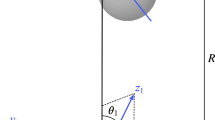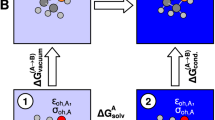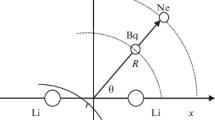Abstract
A five site potential model combining Lennard–Jones plus Coulomb potential functions has been developed for chloroform molecule. The partial charges needed for Coulombic interactions were derived using the chelpg procedure implemented in the gaussian 92 program. These calculations were performed at the MP2 level with MC-311G* basis set for Cl and 6-311G** for C and H atoms. The parameters for the Lennard–Jones potentials were optimized to reproduce experimental values for the density and enthalpy of vaporization of the pure liquid at 298 K and 1 atm. The statistical mechanics calculations were performed with the Monte Carlo method in the isothermic and isobaric (NpT) ensemble. Besides the values obtained for density, ρ, and molar enthalpy of vaporization at constant pressure, Δ HV, for liquid chloroform, results for molar volume, Vm, molar heat capacity, Cp, isobaric thermal expansivity, αp, and isothermal compressibility, κT, for this pure liquid are also in very good agreement with experimental observations. Size effects on the values of thermodynamic properties were investigated. The potential model was also tested by computing the free energy for solvating one chloroform molecule into its own liquid at 298 K using a statistical perturbation approach. The result obtained compares well with the experimental value. Site–site pair correlation functions were calculated and are in good accordance with theoretical results available in the literature. Dipole–dipole correlation functions for the present five site model were also calculated at different carbon–carbon distances. These correlations were compared to those obtained using the four site model reported in the literature. An investigation of the solvent dependence of the relative free energy for cis/trans conversion of a hypothetical solute in TIP4P water and chloroform was accomplished. The results show strong interaction of water and chloroform molecules with the gauche conformer. The value obtained for the free energy barrier for cis/trans rotation in TIP4P water is higher than that for chloroform. This result is in agreement with the continuous theory for solvation as the conformer with higher dipole moment is more favoured by the solvent with higher dieletric constant. The results also show an increase in entropy as the solute goes from the cis to the trans geometry and this result is more appreciable in the aqueous solution.
Similar content being viewed by others
References
J. P. Hansen and I. R. McDonald: Theory of Simple Liquids. Academic Press, London (1986).
J. P. Allen and D. J. Tildesley: Computer Simulation of Liquids. Clarendon, Oxford (1987).
J. J. C. Teixeira-Dias (ed.): Molecular Liquids: New Perspectives in Physics and Chemistry. Kluwer Acad. Pub., Dordrecht (1992).
M. W. Evans (ed.): Dynamical Processes in Condensed Matter. Wiley, New York (1985).
W. L. Jorgensen, J. M. Briggs, and M. L. Contreras: J. Phys. Chem. 94, 1683 (1990).
H. Kovaks, J. Kowalewski, and A. Laaksonen: J. Phys. Chem. 94, 7378 (1990).
M W. Evans: J. Mol. Liquids 25, 211 (1983).
W. Dietz and K. Heinzinger: Ber. Bunsenges. Phys. Chem. 89, 968 (1985).
H. J. Böhm and R. Ahlrichs: Mol. Phys. 54, 1261 (1985).
M. Jen and D. R. Lide Jr.: J. Chem Phys. 36, 2525 (1962).
H. Bertagnolli, D. O. Leicht, and M. D. Zeidler: Mol. Phys. 35, 193 (1978).
H. Bertagnolli, D. O. Leicht, M.D. Zeidler, and P. Chieux: Mol. Phys. 35, 199 (1978).
L. C. G. Freitas and J. M. M. Cordeiro: J. Mol. Struct. (Theochem) 335, 189 (1995).
C. M. Breneman and K. B. Wiberg: J. Comp. Chem. 11, 361 (1990).
M. J. Frisch, G. W. Trucks, M. Head-Gordon, P. M. W. Gill, M. W. Wong, J. B. Foresman, B. G. Johnson, H. B. Schlegel, M. A. Robb, E. S. Repogle, R. Gomperts, J. L. Andres, K. Ragharachari, and J. S. Bink: GAUSSIAN 92, Revision C, Gaussian, Inc., Pittsburg PA (1992).
A. D. McLean and G. S. Chandler: J. Chem. Phys. 72, 5639 (1980).
A. L. McClellan: Tables of Experimental Dipole Moments. Freeman, London (1963).
B. H. Besler, K.M. Merz Jr., and P. A. Kollman: J. Comp. Chem. 11, 431 (1990).
K. M. Merz Jr.: J. Comp. Chem. 13, 749 (1992).
H. A. Carlson, T. B. Nguyen, M. Orozco, and W. L. Jorgensen: J. Comp. Chem. 14, 1240 (1993).
K B. Wiberg and P. R. Rablen: J. Comp. Chem. 14, 1504 (1993).
D. Chandler: Ann. Rev. Phys. Chem. 29, 441 (1978).
C. S. Hsu and D. Chandler: Mol. Phys. 37, 299 (1979).
C. F. Jumper, M. T. Emerson, and B. B. Howard: J. Chem. Phys. 35, 1911 (1961).
J. A. Riddick and W. B. Bunger: Organic Solvents. Wiley, New York (1970).
V. Majer, L. Šváb, and V. Svoboda: J. Chem. Thermodynamics 12, 843 (1980).
N. Metropolis, A. W. Rosenbluth, M. N. Rosenbluth, A. H. Teller, and E. Teller: J. Chem. Phys. 21, 1087 (1953).
L. C. G. Freitas: DIADORIM Program Version 2.0, Universidade Federal de São Carlos, Departamento de Química (1995).
L. C. G. Freitas: J. Mol. Struct. (Theochem) 282, 151 (1993).
R. W. Zwanzig: J. Chem. Phys. 22, 1420 (1954).
W. F. V. Gunsteren and P. K. Weiner (eds.): Computer Simulation of Biomolecular Systems: Theoretical and Experimental Applications, ESCOM, Leiden (1989).
D. L. Beveridge and F. M. DiCapua: Ann. Rev. Biophys. Chem. 18, 431 (1989).
J. C. Owicki and H. A. Scheraga: Chem. Phys. Lett. 47, 600 (1977).
H. Bertagnolli: Ber. Bunsenges. Phys. Chem. 85, 644 (1981).
H. Bertagnolli, D. O. Leicht, M. D. Zeidler, and P. Chieux: Mol. Phys. 36, 1769 (1978).
H. Bertagnolli and P. Chieux: Ber. Bunsenges. Phys. Chem. 84, 1225 (1980).
A. Ben-Naim and Y. Marcus: J. Chem. Phys. 81, 2016 (1984).
W. L. Jorgensen, J. Chandrasenkhar, J. D. Madura, R.W. Impey, and M. L. Klein: J. Chem. Phys. 79, 926 (1983).
W. L. Jorgensen, J. D. Madura, and C. J. Swenson: J. Am. Chem. Soc. 106, 6638 (1984).
T. A. Andrea, W. C. Swope, and H. C. Andersen: J. Chem. Phys. 4576 (1983).
R. J. Abraham and E. Bretschneider: in Internal Rotation in Molecules, W. J. Orville-Thomas (ed.), Ch. 13. Wiley, New York (1974).
Y. Marcus: Ion Solvation. Wiley, New York (1985).
Author information
Authors and Affiliations
Rights and permissions
About this article
Cite this article
Barlette, V.E., Garbujo, F.L.L. & Freitas, L.C.G. Monte Carlo Study of Structural and Thermodynamic Properties of Liquid Chloroform Using a Five Site Model. Molecular Engineering 7, 439–455 (1997). https://doi.org/10.1023/A:1008232630306
Issue Date:
DOI: https://doi.org/10.1023/A:1008232630306




